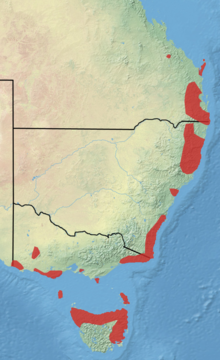Long-snouted rabbit kangaroo
| Long-snouted rabbit kangaroo | ||||||||||||
|---|---|---|---|---|---|---|---|---|---|---|---|---|

Long-snouted rabbit kangaroo ( Potorous tridactylus ) |
||||||||||||
| Systematics | ||||||||||||
|
||||||||||||
| Scientific name | ||||||||||||
| Potorous tridactylus | ||||||||||||
| ( Kerr , 1792) |
The long-nosed rabbit kangaroo ( Potorous tridactylus ), also known as the long-nosed rabbit kangaroo , is a marsupial from the rat kangaroo family (Potoroidae).
Distribution and subspecies
There are three subspecies:
- Potorous tridactylus tridactylus , southeast Queensland along the coast to Gosford in New South Wales , also on Fraser Island .
- Potorous tridactylus apicalis , on Tasmania (but not in the mountains in the center), Bruny Island , Hunter Island , Maria Island , Robbins Island and Three Hummock Island .
- Potorous tridactylus trisulcatus , south of Sydney along the south coast of Victoria to the extreme southeast of South Australia , also French Island and Grampians National Park
Appearance
The long-snouted rabbit kangaroo reaches a head body length of 30 to 41 cm, has a 19 to 26 cm long tail and weighs 0.66 to 1.7 kg. Males are on average slightly larger than the females. On the back, the animals are brown, gray or reddish in color, often with light brown or yellowish sprinkles. The ventral side is rather light gray. The ears are small and rounded. The muzzle is long and pointed, the nose and the skin immediately in front of it are hairless. The hind feet are shorter than the head. The tail is relatively short and only sparsely hairy. In the southern parts of the range, the animals often have white tail tips.
Habitat and way of life
The long-nosed rabbit kangaroo lives in rainforests and moist and dry evergreen forests, heaths, and open woodlands. The soil is often sandy. The animals are solitary and less nocturnal than other rat kangaroos. They often become active before sunrise and in some regions remain active during the day. Long-snouted rabbit kangaroos spend their resting time alone or in pairs in hiding places in bushes or under tree trunks. The territories of the males are 2 to 19 hectares in size, those of the females are significantly smaller with 1 to 5 hectares. The species feeds mainly on truffle-like mushrooms that grow underground and are dug up with their front paws. In addition, seeds, fruits, leaves, plant stems and flowers are eaten. Mushrooms make up 25 to 33% of their diet in spring and summer, in the rest of the year the proportion rises to over 50% (maximum over 80%).
The gestation period is about 38 days. After birth, the young animal remains in the pouch for about 4 to 5 months and is weaned at 5 months and sexually mature at 12 months. A female can have two to three young a year.
Danger
The long-snouted rabbit kangaroo is classified as Near Threatened by the IUCN . Large parts of the original distribution area are used by humans today. Many populations are therefore isolated today. The animals are even more common on Tasmania than on the mainland. The main threat to the species today are red foxes , domestic cats and feral dogs. The two southern subspecies are now bred in captivity.
supporting documents
- ↑ a b c d Mark Eldridge & Greta Frankham: Family Potoroidae (Bettongs and Potoroos). Page 628 in Don E. Wilson , Russell A. Mittermeier : Handbook of the Mammals of the World - Volume 5. Monotremes and Marsupials. Lynx Editions, 2015, ISBN 978-84-96553-99-6
- ↑ Potorous tridactylus in the endangered Red List species the IUCN 2016 Posted by: Woinarski, J. & Burbidge, AA, 2014. Accessed March 15, 2018th
